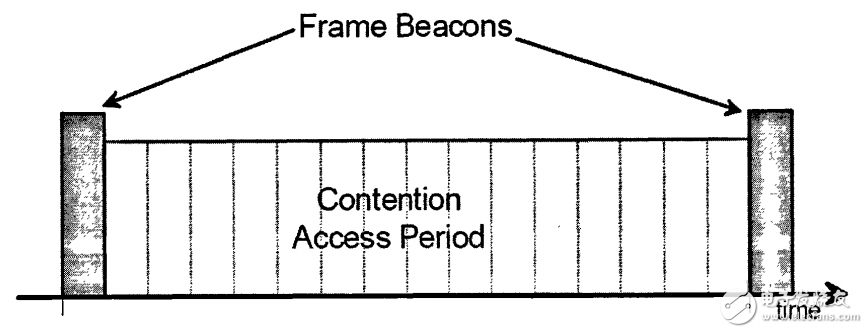1.1.1 Superframe structure
The low speed wireless personal area network allows for the optional use of a superframe structure. The format of the superframe is determined by the coordinator. In the mode using the superframe structure, the coordinator periodically transmits a beacon frame according to the setting, and the superframe is divided by the beacon frame in the network, and the middle region is called a competition access period ( CAP, contenTIonaccess period), as shown in Figure 1.1. If the coordinator does not need to use a superframe structure, it can stop sending beacon frames. The beacon frame can be used to identify the personal area network, synchronize the devices in the personal area network, and describe the superframe structure.

Figure 1.1 Superframe structure without GTSs
For situations where the network load is low or where a specific transmission bandwidth is required, the coordinator can divide a portion of the time from the superframe to specifically serve such a transmission request. The time divided is called a guaranteed time slot (GTSs.Guaranteed TIme slots). A set of guaranteed time slots in a superframe is called a non-competitive access (CFP), which is often followed by a contention access period, as shown in Figure 1.2. The guaranteed time slot transmission mode is also optional, and is applied by the ordinary device to the personal area network coordinator. The coordinator will reply according to the current resource status, and broadcast the structure of the next super frame to the network through the beacon frame. The data transmission during the contention period must end before the start of the non-contention access period: likewise, the data transmission in each guaranteed time slot in the non-contention access period must also be before the start of the next guaranteed time slot or during the non-competition access period. End before the end.

Figure 1.2 Superframe structure with GTSs
Superframes are often divided into active periods (acTIve) and inactive periods (inactive). During the active period, the coordinator is responsible for maintaining the network, and data communication between devices in the personal area network can be performed; in the inactive period, the personal area network coordinator and common equipment can enter the low power mode, in the personal area network. Each device does not transmit data. A complete superframe structure is shown in Figure 1.3.

Figure 1.3 Complete superframe structure
The quantities describing the superframe structure are BO (Beacon Order) and SO (Superframe Order). Among them, BO determines the period of sending the beacon frame, that is, the length of a superframe BI (beacon interval), see (1.1); SO determines the duration of the active period in a superframe, that is, SD (superframe duration), see ( 1.2). Among them, aBaseSuperframeDuration is 960 symbols. According to the agreement, the value of BO ranges from 0 to 14. When BO is 15, it means that the superframe structure is not used. The range of SO is also from 0 to 14, but SO must be no greater than BO. When SO is equal to BO. When it is indicated, the inactive period is not included in the superframe.

1.1.2 MAC layer frame structure and frame classification
The IEEE 802.15.4 MAC layer frame structure is designed to achieve reliable data transmission in a noisy wireless channel environment with minimal complexity. Each MAC sub-layer frame contains three parts: the frame header, the payload, and the end of the frame. The header portion is composed of frame control information, frame sequence number, and address information. The payload portion of the MAC sublayer is variable in length, and the specific content of the payload is determined by the frame type. The end of the frame is a 16-bit CRC check sequence for the header and payload data.
The device address in the MAC sublayer has two formats: a 16-bit (two-byte) short address and a 64-bit (8-byte) extended address. The 16-bit short address is the local address in the personal area network assigned by the coordinator when the device is associated with the personal area network coordinator; the 64-bit extended address is the global unique address, which is allocated before the device enters the network. The 16-bit short address can only be guaranteed to be unique within the personal area network, so it is meaningful to combine the 16-bit personal area network identifier when using 16-bit short address communication. The length of the address information of the two address types is different, so the length of the MAC frame header is also variable. Which address type a data frame uses is identified by the frame control field.
The IEEE 802.15.4 protocol defines four types of frames: beacon frames, data frames, acknowledgment frames, and MAC command frames.

Figure 1.4 Beacon frame format
contact remove tool, contact crimp tool
Kunshan SVL Electric Co.,Ltd , https://www.svlelectric.com